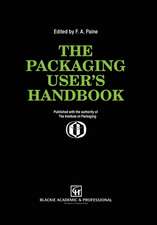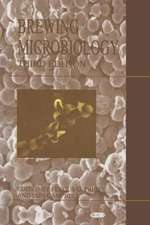Food Hygiene, Microbiology and HACCP
Editat de S. Forsytheen Limba Engleză Paperback – 22 mar 2013
Preț: 397.97 lei
Nou
Puncte Express: 597
Preț estimativ în valută:
76.17€ • 79.21$ • 63.74£
76.17€ • 79.21$ • 63.74£
Carte tipărită la comandă
Livrare economică 14-28 martie
Preluare comenzi: 021 569.72.76
Specificații
ISBN-13: 9781461359197
ISBN-10: 1461359198
Pagini: 468
Ilustrații: XVIII, 449 p.
Dimensiuni: 155 x 235 x 25 mm
Greutate: 0.65 kg
Ediția:1998
Editura: Springer Us
Colecția Springer
Locul publicării:New York, NY, United States
ISBN-10: 1461359198
Pagini: 468
Ilustrații: XVIII, 449 p.
Dimensiuni: 155 x 235 x 25 mm
Greutate: 0.65 kg
Ediția:1998
Editura: Springer Us
Colecția Springer
Locul publicării:New York, NY, United States
Public țintă
ResearchCuprins
1 Fundamental Principles of Microbiology.- 1.1 Introduction.- 1.2 Characterisitics of Bacteria.- 1.3 Types of Bacteria Important in Foods.- 1.4 Characteristics of Fungi.- 1.5 Characteristics of Viruses and Prions.- 1.6 The Growth Curve of Bacteria.- 1.7 Factors Influencing Bacterial Growth.- References.- 2 Food Poisoning and Other Food-borne Hazards.- 2.1 Introduction.- 2.2 Incidence of Food Poisoning.- 2.3 Bacterial Food Poisoning.- 2.4 Mycotoxicoses.- 2.5 Virus Food Poisoning.- 2.6 Animal Toxins and Parasitic Infections.- 2.7 Poisonous Plants.- 2.8 Chemical Poisoning.- References.- 3 Food Spoilage.- 3.1 Introduction.- 3.2 Spoilage of Fresh Meats.- 3.3 Spoilage of Cured Meats.- 3.4 Spoilage of Vacuum-Packed Meats.- 3.5 Spoilage of Poultry.- 3.6 Spoilage of Fish and Shellfish.- 3.7 Dairy Products.- 3.8 Eggs and Egg Products.- 3.9 Vegetables and Fruits.- 3.10 Cereal Based Products.- 3.11 Beer.- 3.12 Wine.- 3.13 Sauerkraut.- 3.14 Canned Foods.- 3.15 Frozen Foods.- 3.16 Dehydrated Foods.-3.17 Irradiated Foods 13.- References.- 4 Microbiological Examining Methods.- 4.1 The Rational of Microbiological Testing.- 4.2 Sampling.- 4.3 Microbiological Test Procedures.- 4.4 Conventional Methods.- 4.5 Rapid Detection Techniques.- 4.6 Microbiological Criteria and Specifications.- References.- 5 Factory Design and Construction.- 5.1 The Factory Site.- 5.2 General Design Principles and Structural Techniques.- 5.3 Construction of Ceilings, Walls and Floors.- 5.4 Ventilation and Air Conditioning.- 5.5 Noise and Vibration.- 6 Factory Layout.- 6.1 Handling of Food Materials.- 6.2 Layout and Integration of Different Work Areas.- Reference.- 7 Design of Food Processing Equipment.- 7.1 Introduction.- 7.2 Legislation.- 7.3 Construction Materials.- 7.4 Growth ‘Pockets’.- 7.5 Ease of Dismantling and Re-assembly of Equipment.- 7.6 Accessibility and the Supporting Framework.- 7.7 External Surfaces.- 7.8 Design Features for Individual Items of Equipment.- References.- 8 HACCP and Product Quality.- 8.1 HACCP and Quality Schemes.- 8.2 Origins of HACCP.- 8.3 Objectives of HACCP.- 8.4 The Seven Principles of HACCP.- 8.5 HACCP-like Implementation.- 8.6 Generic HACCP.- 8.7 Principle 1 — Hazard Analysis.- 8.8 Principle 2 — Critical Control Points.- 8.9 Critical Limits.- 8.10 ATP-bioluminescence and HACCP Monitoring.- 8.11 End-product Testing and Microbiological Criteria.- 8.12 Problems of Implementation.- 8.13 HACCP and Predictive Microbiology.- 8.14 Risk Assessment.- 8.15 Quality Assurance and Quality Control.- 8.16 Raw Material Control.- 8.17 Process Control.- 8.18 Packaging.- 8.19 Finished Product Storage.- 8.20 Transport and Distribution.- 8.21 Total Quality Management and Longitudinal Integrated Safety Assurance.- References.- 9 Cleaning and Disinfection: Methods.- 9.1 Introduction.- 9.2 Definitions.- 9.3 Types of Soil.- 9.4 Removal of Gross Soil.- 9.5 Detergents.- 9.6 Chemical Disinfectants.- 9.7 Use of Heat.- 9.8 Dry Cleaning.- 9.9 Cleaning-in-Place (CIP).- 9.10 MechanicalAids for Cleaning.- 9.11 Foam Cleaning.- 9.12 Cleaning Small Equipment.- 9.13 Paper and Fabric Wipers.- References.- 10 Cleaning and Disinfection: Practical Application.- 10.1 Aims.- 10.2 Cleaning Schedules.- 10.3 Biofilms.- 10.4 Use of Labour.- 10.5 The Role of Management.- 10.6 Miscellaneous Problems Encountered.- 10.7 Assessment of Cleaning Efficiency.- References.- 11 Hygiene and Training of Personnel.- 11.1 Hand Washing and Care of the Hands.- 11.2 Practices, Good and Bad.- 11.3 Health Supervision.- 11.4 Induction and In-Service Training.- References.- 12 World-wide Food Safety Programmes and Legislation.- 12.1 World-wide Food Safety Programmes.- 12.2 Legislation.- 12.3 Food Legislation Within the European Community.- 12.4 International Food Standards.- 12.5 Food Hygiene and Safety Legislation in the UK.- 12.6 Food Legislation In Some European Countries.- 12.7 Food Legislation in the USA.- 12.8 Food Legislation in Japan and Korea.- 12.9 Concluding Remarks.- References.










